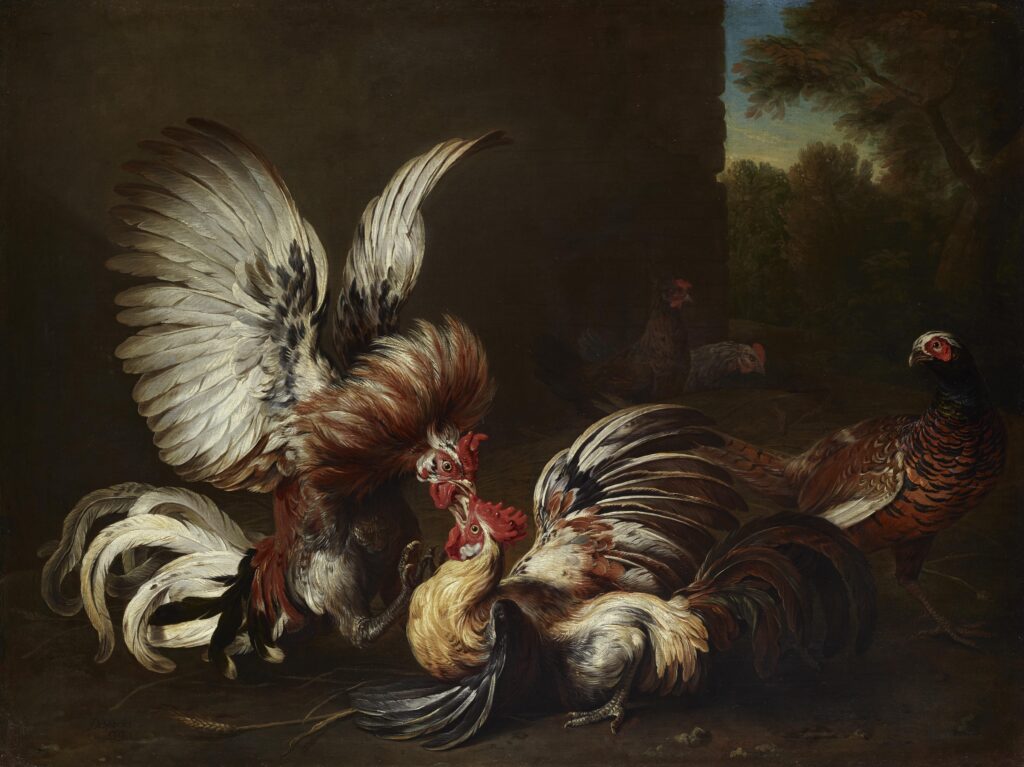Alexandre-Francois Desportes
1661 - 1743
Two Cocks fighting in a Farmyard, a Pheasant and two Hens nearby

Medium:
Oil on Canvas
Category:
Dimensions:
98(h) x 131(w) cms
Framed Dimensions:
116(h) x 148(w) cms
Signed:
Signed and dated lower left: 'Desportes /1713'
Essay:
Alexandre Desportes was the leading painter of sporting and animal subjects in France in the early eighteenth century. He was also a very accomplished portraitist. Born in Champagne, Desportes had humble beginnings as the son of a labourer. He became a pupil of the Flemish artist Nicasius Bernaerts who was himself a former pupil of Frans Snyders. This line of influence meant that Desportes spent much of his career working in the Flemish realist tradition.
During the early part of his career Desportes painted decorative scenes, including theatre sets, and he also spent some time working in the Chateau d'Anet and at Versailles for Louis XIV. In 1695 he left for Poland where he was appointed Court Painter to King Jean Sobieski and he painted portraits of the King and other members of the royal family.
Following the death of the King in 1696, Desportes returned to France and thereafter dedicated himself almost exclusively to sporting pictures. He became Court Painter to Louis XIV and decorated a large number of the royal residences, including the Château de Chantilly, the Hôtel de Bouillon and the Châteaux of La Muette and Compiègne.
Desportes became a member of the Académie in 1699 and in 1704 was made its adviser. In 1712 he travelled to England where he was received with great acclaim. On his return to France he was commissioned by the Gobelins Tapestry Factory to design eight large sporting compositions and he used the King's hounds as models for this commission, portraying each dog individually. Desportes continued to paint until his death in 1743 at the age of 82.
-
Two magnificent fighting cockerels leap and snap at each other, their plumage a sinuous cascade of flashing red, white, and gold. One lunges at the other for a coup de grâce, talons raking, beak plucking at his enemy's comb. A pheasant and two hens watch on with casual interest in their farmyard, a stone wall framing the scene on the left and the outskirts of an orchard on the right.
Desportes' fighting birds derive from a Frans Snyders composition dated 1625 in a private collection in Vienna (see Robels in lit., no. 205). A preparatory drawing for the animal group is also in the British Museum, London (inv. no. 00.9-40). In our picture Desportes has retained Snyders' cockerels, but has swapped a watching hen for a pheasant.
Susan Koslow writes of paintings of birds in the 1600s that while exotic animals spoke of immense luxury, chickens and other farmyard fowl, once associated with rusticity and peasantry, came to be seen as status symbols because they refer to the farmyard of an estate, thus indicating landownership and wealth. This was a trend which developed over the 17th century as the improvement of land and animal husbandry became signs of an educated and proactive land owner. By the mid-18th century these qualities were considered paramount to the landed elite around Europe. This might explain why Desportes - working almost 100 years after Snyders' models - has placed his cockfight firmly in a farmyard setting rather than Snyders' slightly more ambiguous muddy fields, semi-wilderness, or barns.
In the catalogue of the sale of William Morehead in Edinburgh in 1835 it is noted that the present painting was a 'companion' to the subsequent lot; another work by Desportes described as 'Dogs and Cats Fighting'. The dimensions are not noted and it could refer to several works in Desportes' oeuvre. It is possible that these two works may have originally been intended by Desportes to form a pair, or it may simply have been a connection made by Morehead and the auction house.
Provenance:
William Morehead, Esq. of Herbertshire Castle (? - 1834);
His estate sale; C.B. Tait, Edinburgh, 23 Jan. 1835, lot 53.
Sale of Chaplin; Edward Foster, London, 15 April 1835, lot 73a (sold to Smart for 2 - 12 pounds)
Mrs VAR Dance, Moreton House, Moreton Morrell, Warwickshire;
Her sale, Heathcote Ball & Co. Locke & England, Leicester, 8 Dec. 1977, lot 377.
Literature:
H. Robels, Frans Snyders: Stilleben- und Tiermaler 1579-1657, Munich, 1989, p. 313, no. 205b.
P. Jacky, François Desportes (1661-1743), PhD dissertation, Paris, 1999, IV, pp. 639-40, no. P542.
G. de Lastic and P. Jacky, Desportes Catalog Raisonné, Saint-Rémy-en-l'Eau, 2010, II, p. 139, no. P542.